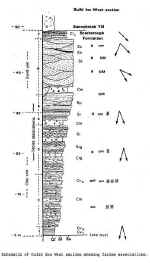|
1983.
M.Sc., 122 pp.
A
SEDIMENTOLOGICAL STUDY OF THE EARLY WISCONSIN SCARBOROUGH FORMATION, TORONTO,
ONTARIO
Kelly,
R. I.
 The
Scarborough Formation of presumed Early Wisconsin age represents a deltaic-lacustrine
deposit formed in the Toronto area. It is exposed along the Scarborough Bluffs
and some inland creeks. The
Scarborough Formation of presumed Early Wisconsin age represents a deltaic-lacustrine
deposit formed in the Toronto area. It is exposed along the Scarborough Bluffs
and some inland creeks.
The formation is composed of a lower
clay rich, distal unit (30 m thick), overlain by a more proximal sandy upper
unit (20 m thick). The formation is capped by the Early Wisconsin age Sunnybrook
Till. The Scarborough sequence was deposited in a lake whose water level stood
approximately 45 metres above present level.
The two units of the Scarborough
Formation comprise several laterally persistent facies associations. The
lowermost associations are characterized by clay and silt rich rhythmites
(association 1) which become siltier and sandier upwards (association 2).
Sedimentation from turbid flows prevails here. In higher associations there is a
progressive coarsening and an increase in rippled sandy layers. These
lithofacies indicate a progressive increase in importance of bottom traction
currents in the shoaling delta front (associations 3 and 4).
Facies association 5 marks the
transition between the submerged part of the delta and the predominantly
continental topsets. It is characterized by interbedded parallel laminated and
rippled sands. Clay drapes cap many of the rippled layers.
The delta topsets (association 6)
are composed of a variety of crossbeds. Trough crossbeds, formed in dunes and
planar crossbeds formed in bars are most common. Massive, fairly well sorted
sands which infilled channels under supercritical flow conditions, are
occasionally present. Mud pebbles and abundant plant fragments attest to the
numerous cut and fills typical of braided stream deposits. Local large
crossbedded units are remnants of eolian dunes. Subaerial conditions are also
indicated by localized mud-cracked clay surfaces.
This sandy sequence is capped by a
relatively thin (2 to 3 metre thick) unit which has well developed clay-silt
rhythmites and contains numerous small faults. This upper association
(association 7) may represent the re-establishment of submerged lacustrine
conditions in front of the advancing glacier which deposited the overlying
Sunnybrook Till. The weight of the glacier and till resulted in microfaulting of
the sediments.
The apparently regular prograding
sequence of the Scarborough Formation is strongly modified in the clay unit and
lower part of the sand unit by several recurring "massive" sandy-silt
layers. These layers consist of an apparently massive or faintly laminated
sandy-silt matrix which encloses numerous pseudonodules of fairly well sorted
medium sand. Small (1 to 2 rom), disseminated plant fragments are scattered
throughout the matrix. The base of some layers contain ripped up underlying
sediments. These beds generally show distinct upper and lower bounding surfaces.
Massive layers in lower sections of the Scarborough Formation can be traced for
the length of the outcrop (over 2 km). Layers in upper facies associations pinch
out over 200 to 300 m or are abruptly cut off by channels. Many of the massive
units are composite deposits. Mineralogically the massive units are not
drastically different from other lithologies. Their grain size and structures
suggest that they are derived from stubaqueous sediment gravity flows. These
gravity flows were released directly from in front of. or from bottom melt out
of a glacier. The presence of such a glacier in the Toronto area during
deposition of the Scarborough Formation would also provide the large amount of
sand for the upper Scarborough lithofacies as well as waterlaid material
deposited through turbid flo,v in the distal areas and bottom currents in more
proximal parts.
.
|